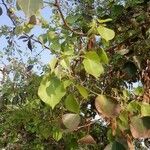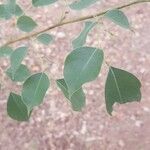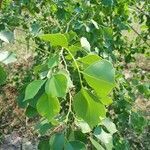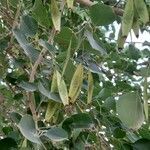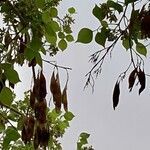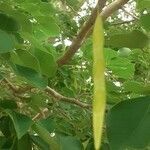| Therapeutic use
|
Diuretics (aerial part), Spasm (aerial part), Abortifacient agents (bark), Amenorrhea (bark), Analgesics (bark), Anthelmintics (bark), Anti-inflammatory agents (bark), Antioxidants (bark), Antipyretics (bark), Aphrodisiacs (bark), Appetite stimulants (bark), Astringents (bark), Bronchitis (bark), Diabetes mellitus (bark), Dysentery (bark), Dysmenorrhea (bark), Dyspepsia (bark), Dysuria (bark), Edema (bark), Erysipelas (bark), Expectorants (bark), Eye pain (bark), Fever (bark), Genital diseases, female (bark), Gout (bark), Graves ophthalmopathy (bark), Helminthiasis (bark), Hemorrhage (bark), Hemostasis (bark), Hiccup (bark), Inflammation (bark), Insect repellents (bark), Leprosy (bark), Menstruation-inducing agents (bark), Neuritis (bark), Pain (bark), Pruritus (bark), General tonic for rejuvenation (bark), Scabies (bark), Sciatica (bark), Sinusitis (bark), Skin diseases (bark), Stomach diseases (bark), Syphilis (bark), Thirst (bark), Ulcer (bark), Urinary tract infections (bark), Urination disorders (bark), Vitiligo (bark), Vomiting (bark), Wound healing (bark), Analgesics (leaf), Anthelmintics (leaf), Anti-inflammatory agents (leaf), Antioxidants (leaf), Antipyretics (leaf), Astringents (leaf), Cholera (leaf), Colic (leaf), Diabetes mellitus (leaf), Diarrhea (leaf), Diuretics (leaf), Dysentery (leaf), Dyspepsia (leaf), Dysuria (leaf), Edema (leaf), Exanthema (leaf), Eye diseases (leaf), Eye pain (leaf), Furunculosis (leaf), Gastrointestinal diseases (leaf), Genital diseases, female (leaf), Gonorrhea (leaf), Graves ophthalmopathy (leaf), Hemorrhage (leaf), Hemostatics (leaf), Inflammation (leaf), Leukorrhea (leaf), Menorrhagia (leaf), Mental disorders (leaf), Pain (leaf), General tonic for rejuvenation (leaf), Sunstroke (leaf), Vomiting (leaf), Mental disorders (plant exudate), Astringents (root), Diarrhea (root), Dysentery (root), Insect repellents (root), Dysentery (stem), Excoriation (unspecified), Gonorrhea (unspecified), Skin (unspecified), Stimulant (unspecified), Anthelmintics (unspecified), Antiemetics (unspecified), Antirheumatic agents (unspecified), Cough (unspecified), Exanthema (unspecified), Furunculosis (unspecified), Hemorrhoids (unspecified), Inflammation (unspecified), Intestinal diseases, parasitic (unspecified), Leprosy (unspecified), Menorrhagia (unspecified), Parasympatholytics (unspecified), General tonic for rejuvenation (unspecified), Skin diseases (unspecified), Vomiting (unspecified), Abdominal pain (wood), Anemia (wood), Anthelmintics (wood), Antiemetics (wood), Appetite stimulants (wood), Bronchitis (wood), Cachexia (wood), Calculi (wood), Diabetes mellitus (wood), Diarrhea (wood), Dysentery (wood), Dyspepsia (wood), Edema (wood), Emetics (wood), Exanthema (wood), Fever (wood), Furunculosis (wood), Gout (wood), Helminthiasis (wood), Hematologic diseases (wood), Hemorrhoids (wood), Hiccup (wood), Leprosy (wood), Lithiasis (wood), Neuritis (wood), Pain (wood), Scabies (wood), Sciatica (wood), Sinusitis (wood), Skin diseases (wood), Syphilis (wood), Ulcer (wood), Urinary bladder diseases (wood), Urination disorders (wood), Vitiligo (wood), Vomiting (wood), Wounds and injuries (wood)
|
